Eurythmy as Visible Speech
GA 279
XIV. The Structure of Words, The Inner Structure of Verse
11 July 1924, Dornach
Just as in speech itself an inner understanding for the structure of language makes it necessary to divide words, according to the train of thought, into nouns, adjectives, etc., so, in eurhythmy, also these things must be taken into consideration. It is, of course, obvious that all pedantry must here be laid aside, and that the teaching of eurythmy from the aspect which we shall be developing here to-day must never be allowed to degenerate into those methods too frequently employed in the teaching of grammar in schools. But the eurythmist must be fully conscious of the way in which each single word,—a noun, for instance,—must be treated; for these details have their place in the whole scheme of the structure of language, by means of which the human being is enabled to express himself through speech. It is necessary then to differentiate between words which express the characteristics of things, descriptive words, and words expressing activities. Such words as describe the characteristics of things may be expressed in eurythmy by checking the movement of the form. Just at the moment when one wishes to express an adjective in eurythmy one must pause in the form and make the gestures standing still; the gestures must be made during a quiet interval in the form. On the other hand, when we are expressing some soul-content, as we do in ordinary speech by means of a verb, the point is to accompany the gestures by a decided movement in the form. Thus, gestures accompanied by movement, gestures carried out by the human being in motion, may be said to be the expression of the verb.
Now, one can sub-divide that which is expressed by means of the verb in this way; we may have the expression of something passive or of something active, or of something prolonged over a certain period of time. A transient activity, a transient passivity, or a prolonged activity, a prolonged passivity,—it is according to this that we can differentiate our eurythmic gestures. When we wish to express passivity, a passive relationship to something, the gestures must be made while the eurythmist moves in a forwards direction, not in a backwards direction. Everything which is inwardly connected with suffering, endurance, with a passive attitude, may be expressed by making the gestures to a forward-moving form; everything active may be expressed by making the gestures to a backward-movement in the form; while everything, either active or passive, which is of the nature of duration, may be expressed by making the gestures to a form which moves from side to side.
Thus we are able to express the verbal element in a way which enables the onlooker to perceive what actually lies in the nature of the verb.
We will now apply what has just been said to the working out of a short poem; we will try to bring out these three forms of inner experience as they come to expression in the verb. Let us, then, examine the verbs as they occur in this little poem:
Konnt' schlafen nicht (I could not sleep)
Sleep is something,—at least in the case of healthy people,—which has a certain duration; so here we must express something which lasts over a period of time (see diagram).
Konnt' traumen nicht (I could not dream).
Now it may be said of drearing,—and we must always analyse a poem in this way before working it out in eurythmy,—it may be said of dreaming that this also is something involving duration, but here at the same time a slight passivity is indicated. We must try to combine the side-to-side movement in the form with the forwards movement, not now going directly forwards, but in a diagonal line. You could express ‘dreaming’ by this form (see page 215). The poem continues:
Konnt' schlafen nicht,
Konnt' traumen nicht
Da hort' ich drauss'
Wie das Eis zerbricht(I could not sleep,
I could not dream
I heard without
How the ice was shattered.)
In ‘heard' we have another verb; ‘heard' is quite obviously passive, so the line must be forwards. ‘How the ice was shattered'; we must bear in mind here that something is being said about the ice. Let us inquire: Is this the passive mood or the mood' of duration?—If we enter into the feeling of this phrase we shall realize that we have to do with the mood of duration; but that there is also the indication of something happening, of something active. The shattering of the ice is the reverse of the purely passive mood; it may even be said to make an aggressive impression upon us. We say: ‘shattered' . . . this crackling of the breaking ice is continuous . . . and at the same time we must express the active mood by moving up to a point in a backwards direction.
Then we have a line without a verb; at least there is only an auxiliary verb and we will not consider this for the moment.
Es war, als ob aus der Ferne
Es sich nahete
Wehete, lüftete,
Und in den Lüften es
Atmete, duftete.(It was as if from afar
Something approached
Wafted, floating aloft,
As if something in the air
Breathed, sending forth fragrance.)
To approach, to be wafted, to float,—all these verbs express duration, but they have at the same time something active about them. Here, then, we must express these verbs: ‘to waft' ‘to float' by a line which goes backwards, and again backwards; ‘as if something in the air' . . . here we have no verb—‘breathed, sending forth fragrance ' . . . must be treated in the same way as ‘wafted, floating aloft'. We have therefore, to move in a backwards direction, and then again further back (see diagram).
(Over the meadows Down the valley, up the mountain,
Wenn das der Fruhling war' As though the spring were come
In full career!)
Now do the whole poem characterizing the different types of verb:
Early Spring.
(I could not sleep,
I could not dream,
I heard without
How the ice was shattered It was as if from afar, Something approached, Wafted, floating aloft, As if something in the air Breathed, sending forth
fragrance.
Over the meadows
Down the valley, up the mountain
Wenn das der Friihling war' As though the Spring were come
In full career!)
We have then these different types of verb:1The reader should look at all diagrams as though facing a stage. Hence a downward arrow = a line forwards.
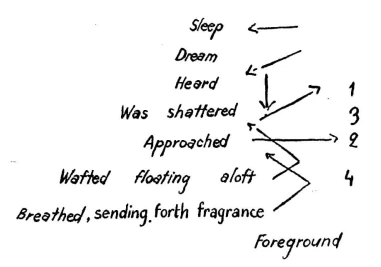
Now we must define the nouns. Here in the first place we have those nouns which describe such things as make an impression upon the senses, things which in ordinary life are termed concrete objects.
It is, of course, impossible to state definitely what is concrete and what abstract; this must be left to individual judgment. Hegel, for instance, protested against the usual conception of ‘abstract' and ‘concrete'. He declared that a washerwoman is something very abstract, whereas wisdom is absolutely concrete!
Everything depends upon whether one is able to conceive wisdom as something concrete and a washerwoman as an abstraction! Anyone who conceives wisdom as concrete will certainly feel that a washerwoman is merely existent in thought and quite without reality. A washerwoman has no real existence. The human being embodied within her exists, but, in her capacity of washerwoman, she is altogether unreal.
For this reason it is perhaps better to say: Objects which produce an impression upon the senses are described by words which must be expressed in the form by an angle backwards. All objects producing an impression upon the senses correspond to a backward angle in the form.
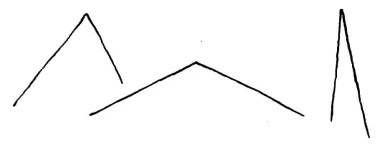
On the other hand that which in the ordinary sense of the word is termed abstract,—everything, that is to say, which makes no impression upon the physical senses but depends upon experiences of the soul, as for instance: wisdom, thought-power, genius, fantasy and countless other qualities,—everything of this nature must be expressed by means of a curved line in a forwards direction.
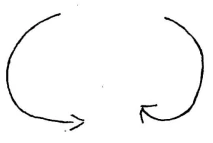
Thus the mental-contemplative element, as we may call it, is expressed in this way, and this gives us two separate forms corresponding with two classes of substantives.2Dr. Steiner had previously given indications as to how words describing spiritual beings (God, Zeus, Dionysus, etc.) should be shown in the form. Such words are expressed by a curved line backwards.
There is also another type of noun which expresses condition. We might take as examples: whiteness, beauty, height. In the case of these nouns of condition we reverse the form which we use for objects perceptible to the senses. We make the angle forwards.
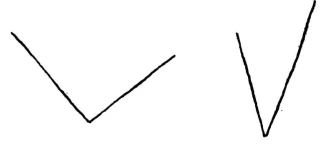
Then, further, we have words which express such things as are purely bound up with the soul-life. Here the curve line becomes more complicated.

In this way we are able to show nouns expressing some mood of soul; yearning, suffering, pain, pity, good-will, and so on. By means of the angle forwards we express conditions which appear as attributes of external objects; while for everything dependent upon the inner soul-life we must use such a form as I have just described.
In this way you will discover movements capable of arousing in the onlookers shades of feeling and perception which will enable him to follow the inner laws which determine why a certain combination of sounds conveys a definite mood of soul, a distinct condition or sense-impression.
It is not necessary to move a separate form for each individual word; with the pronouns, as with the adjectives, the movements may be made standing still. Numerals also should be treated like adjectives; they need not, in so far as eurythmy is concerned, be differentiated from the ordinary adjective.
Interjections, on the other hand,—Oh! for instance, or Ah!—have a quite special significance, for it is by such words as these that beauty and grace may be brought into eurythmy. In the case of all interjections we must either introduce a bending movement of the body, or else a spring or little jump.
Now that I am speaking about a jump or spring I will take the opportunity of drawing your attention once again to the fact that everything of this kind which is introduced into eurythmy must be carried out in such a way that one jumps on to the ball of the foot, only putting the heel down later: there is something fundamentally harmful about any jump which brings one down on to the flat of the foot. Due attention must be paid to this; it has often been overlooked in spite of very definite warnings. In the case of every jump, including those which occur in tone-eurythmy, one must jump on to the fore part of the foot, later bringing the heel into contact with the ground.
Now I am going to make a statement which will most certainly meet with opposition from materialists, but which is, nevertheless, of the utmost importance for the whole sphere of eurythmy, for eurythmy in its artistic, educational and curative aspects. Every single movement from whichever aspect it is regarded, must be carried out with ` grace' in the true sense of the word. And a eurythmy performance, or a lesson in eurythmy, which is not participated in by at least one of the ‘graces ',—I do not, of course, mean this in a physical sense—cannot, my dear friends, be said to be justified. We must have the feeling: All eurythmy, educational as well as artistic, must be of such a nature that one of the Graces might look on without embarrassment.
This, of course, entails an energetic campaign against all lack of skill in eurythmy. And of' all clumsy, awkward things this jumping on to the flat of the foot is the most awkward. As I have already said, every spring or jump must be on to the fore-part of the foot. When in education grace reigns in the sphere of eurythmy, the children actually grow in receptivity and perception in all directions. And teachers of eurythmy must make this increased power of receptivity and perception in the children the goal towards which they strive.
It is through grace alone that art finds its way into the realm of beauty. And in curative eurythmy,—this is the most difficult of all to believe, but it is nevertheless true,—one of the Graces must at least be hovering in the back-ground. Even if not actually visible, she must be listening, and for this reason that every exercise of curative eurythmy not gracefully carried out tends to produce a stiffening and hardening effect in the etheric body, thus counteracting the desired results.
Fri. S. . . . will you now show us some eurythmy into which you must introduce graceful bending movements. You can be quite free to follow your own feeling; but, when I come to the third sentence, try in addition to introduce a graceful jump. With the first of these sentences the movements must be subtle and interesting. I am going to recite three examples; you can express each one by means of the vowel sounds, adding at the same time the movements which I have just indicated:
‘The dog goes bow-wow'.
Introduce a bending movement which really represents the ‘bow-wow'.
‘The cat goes mi-auw!' . . .
and now, with the third gesture, make three graceful little jumps, combining the last jump with some sort of bending movement:
‘The cock goes cock-a-doodle-doo!'
In this way we get the interjections.
Further we have the prepositions. Some sort of acquaintance with these matters is, of course, essential. One must realize, for instance, that the prepositions express the relation-ship in which one thing stands to another. We have such words as: aus (out), ausser (outside), bei (with, among), entgegen (towards), mit (with), nach (after), nachst (next), von (of), zu (to), zuwider (contrary to),—all prepositions which, as we say, govern the dative; they are always followed by the dative, by the so-called third case. All prepositions must be expressed by a bending of the head and body in a sideways direction.
Here again, however, we must learn to differentiate. In the case of prepositions governing the dative the body must be bent, not sideways merely, but also slightly forwards, in a diagonal direction either to right or left; in the case of those governing the accusative the bending must be directly either to left or right; while in the case of those governing the genitive the movement must be sideways, and also slightly backwards.
In this way we get more variety. Let us now try to express the preposition in the following little poem. I shall ask Frau. P. . . . to express the preposition, when it occurs, by means of the corresponding movement.
‘Was mag es bedeuten? '
This is a question. In this connection we spoke earlier of the spiral form and now we have an opportunity of applying it.
Was mag es bedeuten?
Mein Herz pocht so geschwind,
Die Glocken sie Tauten
Im Morgenwind. (Bending movement forwards and sideways.)
You can, then, express prepositions in this way. On the other hand, a bending of the head only is the expression for conjunctions,—and, but, etc.—for those words whose function it is to connect other words and sentences.
To-day I want to speak of the way in which the structure of a poem may be shown by means of eurythmy forms. We must naturally try to make this course of lectures as comprehensive as possible, and with this in view I will now touch upon certain things which may help us to bring out the actual form of a poem, and to express this in eurythmy. To begin with I will show you how one may treat a poem in which the same form of verse, the same inner structure of the verse, is constantly repeated. We will suppose, for instance, that we have a verse of four lines, and we will see how such a four-lined verse can be worked out. . . . There are, of course many other possibilities. I do not mean to imply that every verse of four lines must be built up in this way, but it can be so built up.
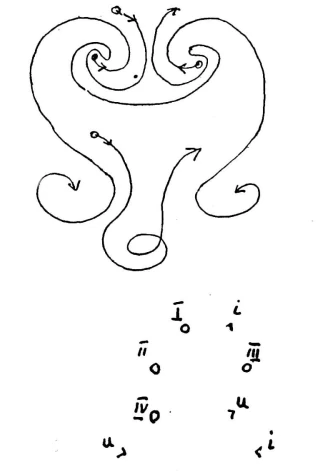
One eurythmist must stand here (1), and move the first form, trying to find his way into it for the first line of the verse. The second eurythmist who stands here, does this form, trying to find his way into the second line, and of course only moving when this second line is being recited. The third must stand here, and during the recitation of the third line must move this form (forwards); and the fourth moves the fourth line to this last form (foreground). But now we must also observe the structure of this verse and see how the rhymes occur; the first line rhymes with the third, and the second with the fourth. We can show this quite clearly by making the eurythmist who does the first line continue to hold the i-gesture. This must also be done in the case of the third line; here again the i-gesture must be held. The eurythmist doing the second line continues to hold the u-gesture; and this same u-gesture must be shown by the fourth eurythmist.
This example shows you, in principle, the way in which the forms and movements of eurythmy may be drawn out from the actual structure of a poem. Will four of you take these places,—you will learn the form in a moment by looking at the diagram on the blackboard,—and now I will read a poem in which the structure of the verse corresponds to the form just described. This will show you how you can find your way into the building up of eurythmic forms. For one must not build up a form merely by vague dreaming, or by indefinite, muddling methods; a form must be made to correspond to what is actually contained in the text itself; and this can be done by bearing in mind all that has been said.
You will at first, of course, only be able to move the form as such, but, when you have had time to practise, you must try to bring into such a form those details of grammatical structure to which I have referred to-day. All this can also be introduced,—but you need not think, when a movement forwards is indicated, that you must immediately take ten steps! The slightest indication is quite sufficient, and indeed the effect is most beautiful when these things are suggested only. To-day I will not impose too much upon you, but will ask you simply to run the form, not showing the additional grammatical details. To do this would be comparatively difficult, but it is nevertheless possible, with adequate practice. The poem runs thus:
Scheiden
Was mag es bedeuten?
Mein Herz pocht so geschwind.
Die Glocken, sie Tauten
Im Morgenwind.Was mag es bedeuten?
Mein Herz ist wund.
Die Glocken, sie lauten
Die Abschiedsstund.Die Glocken, sie klagen.
Mein Herz tut mir weh,
Die Stund hat geschlagen
Ade, Ade.Die Stund hat geschlagen.
Das Herz klopft so sehr.
Ich sitz in dem Wagen
Komm nimmermehr.
In this way then (see previous diagram), one can build up the form of a poem. To-morrow I shall speak even more exactly about the structure of poems; to-day I must just add the following:
It is only by repeatedly calling up a certain mood of soul that the eurythmist can gain the receptivity of feeling and perception necessary to expressive gesture. This delicate and fine perception can be awakened in the eurythmist by means of a meditation drawn out from the secret nature of the human organization. It can be attained when you enter, in deep and inward meditation, into what lies in the following words, not feeling them as words merely, as abstract concepts, but allowing their content to ripen within you. It is thus that you will be able to achieve all that I have just described.
I seek within me
The Strength of Creative Working,
The Power of Creative Life.
It tells me
The heavy weight of Earth
Through the Word of my feet,
It tells me
The forming power of the Air
Through the Singing of my hands,
It tells me
The strength of Heaven's Light
Through the Thinking of my Head,
So the World in Man
Speaks, sings, thinks.Ich suche im Innern
Der schaffenden Krafte Wirken,
Der schaffenden Machte Leben.
Es sagt mir
Der Erde Schweremacht
Durch meiner Fiisse Wort,
Es sagt mir
Der Liifte Formgewalt
Durch meiner Hande Singen,
Es sagt mir
Des Himmels Lichteskraft
Durch meines Hauptes Sinnen,
Wie die Welt im Menschen
Spricht, singt, rinnt
When you have meditated upon such words as these, you will discover that you can say of yourselves: It is as though have awakened out of a cosmic sleep into the heavenly realm of eurythmy. If you stimulate this mood and feeling in your souls, you will be able to enter this realm as though awakening out of the darkness of night into the light of day.

